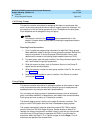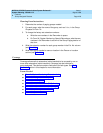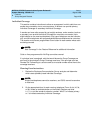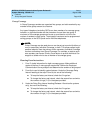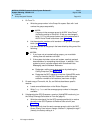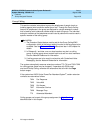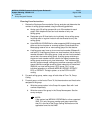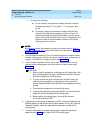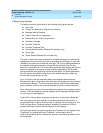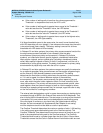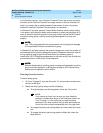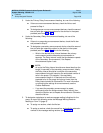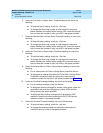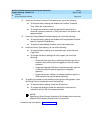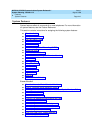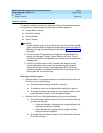
MERLIN LEGENDCommunications System Release 6.1
System Planning
555-661-112
Issue 1
August 1998
Features
Page 4-35Group-Assigned Features
4
Calling Group Options 4
This section contains instructions for the following calling group options:
■ Hunt Type
■ Primary and Secondary Delay Announcements
■ Message-Waiting Receiver
■ Calls-in-Queue Alarm Thresholds
■ External Alert for Calls-in-Queue Alarm
■ Overflow Coverage
■ Overflow Threshold
■ Overflow Threshold Time
■ Prompt-Based Overflow (Release 6.0 and later only)
■ Group Type
■ Queue Control (Release 6.0 and later only)
The order in which the system searches for available calling group members for
subsequent calls can be
circular
,
linear
, or according to which agent is
most idle
(Release 5.0 or later) and is called the
hunt type
. The Circular setting searches for
an available calling group member starting with the extension after the last
extension to receive a call. The Linear setting distributes calls starting with the first
extension assigned to the group through system programming. The Most Idle
setting distributes calls according to the most-idle queue. For some applications,
this hunt type is more efficient than the circular method, because it takes into
account the varying duration of calls.
Up to 10 primary and one secondary delay announcement devices can be
designated for each calling group; more than one calling group can use the same
announcement devices. The announcement devices should not be assigned as
group members, and they are outward-restricted to prevent unauthorized calls.
Each calling group can have only one telephone assigned as its message-waiting
receiver. The same telephone can be assigned as the message-waiting receiver
for more than one calling group.
Three Calls-in-Queue Alarm thresholds can be set to more clearly indicate the
real-time status of the calls waiting in the queue according to the behavior of
programmed Calls-in-Queue Alarm buttons. In Release 4.2 and earlier, only one
Calls-in-Queue Alarm Threshold setting is available to activate the LEDs at
programmed Calls-in-Queue Alarm buttons for a calling group.
Using all three levels, the system manager sets Threshold 3 to the highest value,
Threshold 2 to a middle value, and Threshold 1 to the lowest value. A
Calls-in-Queue Alarm button indicates the severity of the alarm conditions in the
following ways:



